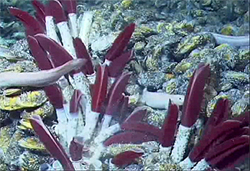 Image courtesy Cindy Lee Van Dover, NSF, and WHOI. Dana Point, California; July 6, 2004 Ocean Institute's "Life in Extreme Environments" Look for Life Where You'd Least Expect It! The Ocean Institute will present a new "Life in Extreme Environments" interactive exhibit, March 19 - July 4, 2005, on Saturdays and Sundays, 10 a.m. - 3 p.m., at the Institute, 24200 Dana Point Harbor Dr., Dana Point. The exhibit, which explores the phenomenon of life in harsh environments such as deep sea floors, icy Antarctic lakes and outer space, is being created in conjunction with the University of Washington, Pennsylvania State University and the Woods Hole Oceanographic Institution. "Life is amazing in its ability to adapt, and life is particularly interesting in extreme environments," says Harry Helling, Vice President of Research and Education. "The fact that entire communities can exist and even thrive near thermal vents on the deep sea floor amazes life scientists. It is our plan to bring Ocean Institute visitors and students right into this fascinating and extreme world." At the interactive exhibit, visitors can experiment with a prototype robot designed to melt through the icy surface of Jupiter's moon Europa; examine giant 6' tube worms preserved for scientific collection; view unseen footage from Woods Hole's deep sea submersible ALVIN; and dissect deepwater gutless mussels, which are specially adapted to live without sunlight on the deep ocean floor. "Visitors will have ample opportunity to interact with scientists, and explore extreme environments with the tools scientists use," Helling added. In fact, during the exhibition, visitors will be able to use videoconferencing equipment to talk live with scientists working on thermal vents at sea. The exhibit is part of a larger Sea Floor Science presentation, made possible with funding from the National Science Foundation, and has other components that allow visitors to play with tidal waves, explore the sunken city of Port Royal, experiment with time-lapse cameras in tidepools and view a collection of 3-D Sea Floor maps. For more information | Home © 2004 by the Ocean Institute and the Regents of the University of California. All rights reserved. Last modifed Friday, October 7, 2004 |
